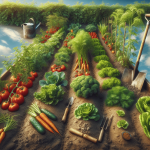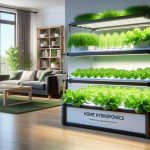This post may contain affiliate links. As an Amazon Associate, we may earn commissions from qualifying purchases.
In “Using Wicking Beds For Efficient Water Usage In Raised Garden Beds,” you’ll discover an innovative gardening method that helps you make the most of your water resources. Picture your garden flourishing with minimal effort as you employ wicking beds, a clever solution designed to keep your plants hydrated from below. By understanding the principles behind this self-watering system, you can transform your raised garden beds into efficient, productive sanctuaries that thrive even in dry conditions. Dive into this guide to learn how wicking beds can enhance your gardening experience and create a sustainable, water-wise garden. Have you ever wondered how you can maximize the efficiency of water usage in your raised garden beds?
Using Wicking Beds for Efficient Water Usage in Raised Garden Beds
You’re in the right place! One innovative method to achieve this is by using wicking beds. Not only do they help in conserving water, but they also promote healthier plant growth with minimal effort. Let’s delve into what wicking beds are and how you can integrate them into your gardening practices.

What are Wicking Beds?
A wicking bed is essentially a self-watering raised garden bed. It uses the process of capillary action (also known as wicking) to transport water from a reservoir at the base of the bed up to the plant roots. This method mimics natural soil hydration, ensuring that plants get a steady supply of water as needed.
The Principle of Wicking
Wicking is a natural process where water moves up through the soil by capillary action. When you water a plant, the water doesn’t just stay at the surface; it gets drawn up through the soil. In a wicking bed, a reservoir at the base of the bed provides a constant source of water, which the soil wicks upward to the plant roots.
Components of a Wicking Bed
Let’s break down the different parts of a wicking bed to understand how it all works:
| Component | Description |
|---|---|
| Container/Base | The structure that holds all the other components. This could be a raised bed frame, an old bathtub, etc. |
| Reservoir | The bottom layer that holds water. This can be created using pond liner, plastic sheeting, or any waterproof material. |
| Wicking Medium | A material such as gravel or coarse sand that allows water to wick upwards efficiently. |
| Geotextile Fabric | A water-permeable fabric that separates the wicking medium from the soil, preventing soil from mixing with the water reservoir. |
| Soil | The top layer where your plants will grow. It needs to be well-draining to allow for proper wicking. |
| Overflow Outlet | Ensures excess water can drain away, preventing waterlogging. |
Why Use Wicking Beds?
So, why should you consider using wicking beds in your garden? Here are some compelling reasons.
Efficient Water Usage
Traditional gardening methods often result in water wastage through surface runoff and evaporation. Wicking beds, on the other hand, drastically reduce these losses. The water is stored and used as needed, which means less frequent watering and a more consistent moisture level for your plants. This is especially beneficial during droughts or in arid climates.
Healthier Plants
Plants in wicking beds are generally healthier because they receive a constant supply of water directly to their roots. The consistent moisture levels reduce stress on plants, making them more resilient and promoting better growth. Plus, because the soil surface remains relatively dry, wicking beds can help reduce the occurrence of soil-borne diseases.
Low Maintenance
Once set up, wicking beds require minimal maintenance. The self-watering system means you don’t need to water your plants as frequently, freeing up your time for other gardening tasks. The need for weeding is also minimized due to the dry soil surface.
How to Build a Wicking Bed
Ready to build your own wicking bed? Here’s a step-by-step guide to help you out.
Choose a Suitable Container
First, you’ll need a suitable container for your wicking bed. This could be a raised garden bed kit, or something repurposed like an old bathtub. Make sure it’s deep enough to include a water reservoir, wicking medium, and soil. Ideally, it should be at least 30 inches deep.
Create the Reservoir
The bottom layer of your wicking bed will be the water reservoir. Line the bottom of your container with a waterproof material such as a pond liner or heavy-duty plastic sheeting. This layer will hold and store water. Make sure the liner covers the entire base and extends up the sides of your container to prevent water from leaking out.
Add the Wicking Medium
Next, fill the reservoir with a wicking medium such as gravel, coarse sand, or small pebbles. These materials allow water to move upwards through capillary action. Aim for a depth of around 4 to 6 inches.
Install the Water Delivery Pipe
To fill the reservoir, install a water delivery pipe at one end of the container. An old piece of PVC pipe works well for this purpose. This pipe should run from the top of the container down to the base of the reservoir layer, allowing you to add water directly to the reservoir.
Add the Geotextile Fabric
Place a layer of geotextile fabric over the wicking medium. This will prevent the soil layer from mixing with the wicking medium while allowing water to pass through. Cut the fabric to size and ensure it covers the entire surface.
Fill with Soil
Now it’s time to add the soil. Use high-quality potting soil or a well-draining soil mix. Fill the container up to the desired level, leaving some space at the top to prevent soil from spilling out. The depth of the soil should be at least 12 to 18 inches to provide enough room for plant roots to grow.
Create an Overflow Outlet
To prevent waterlogging, create an overflow outlet a few inches above the top of the reservoir layer. This can be done by drilling a hole in the side of your container and inserting a small pipe or fitting. The overflow outlet will allow excess water to drain away, ensuring your bed doesn’t become waterlogged.
Fill the Reservoir
Lastly, fill the water reservoir through the water delivery pipe until water starts to trickle out of the overflow outlet. Your wicking bed is now ready to be planted!
Choosing Plants for Wicking Beds
Now that your wicking bed is set up, it’s time to choose the right plants. While most plants will thrive in a wicking bed, certain types are particularly well-suited to this growing method.
Best Plants for Wicking Beds
| Type of Plant | Examples |
|---|---|
| Vegetables | Tomatoes, peppers, cucumbers, lettuce, spinach, radishes |
| Herbs | Basil, parsley, mint, rosemary, thyme |
| Flowers | Marigolds, petunias, zinnias, nasturtiums |
| Fruits | Strawberries, blueberries, dwarf fruit trees (under controlled conditions) |
Plants to Avoid
Some plants are not ideally suited for wicking beds. These include:
- Cacti and Succulents: They prefer dry conditions and can easily become waterlogged in a wicking bed.
- Root Vegetables (like carrots and potatoes): They can often struggle due to the consistently moist conditions, which may lead to rot.

Maintenance Tips
Although wicking beds are low-maintenance, there are a few things you should keep in mind to ensure your plants thrive.
Regularly Check Water Levels
While wicking beds require less frequent watering, it’s still important to check the water levels in the reservoir periodically. Especially during hot or dry periods, the reservoir can empty faster than usual. Refill as necessary through the water delivery pipe.
Monitor Plant Health
Keep an eye on your plants for any signs of stress or disease. Wicking beds should provide a consistent moisture level, but it’s always good to monitor your plants and adjust care as needed.
Clean the Reservoir
Over time, the wicking medium and reservoir may accumulate debris and algae. Cleaning the reservoir once every few months can help maintain the efficiency of your wicking bed. Simply drain the bed and remove any buildup.
Mulch the Surface
Adding a layer of mulch to the soil surface can help reduce evaporation and keep the soil temperature stable. Mulch can also add extra nutrients as it decomposes, further benefiting your plants.
Troubleshooting Common Issues
Even with the best setup, you might encounter some issues. Here are common problems associated with wicking beds and how to troubleshoot them.
Poor Wicking
If you notice that the soil is too dry despite having water in the reservoir, it could be due to poor wicking. Ensure that the wicking medium is properly saturated and that there are no blockages in the water delivery system.
Waterlogging
Waterlogging occurs when the soil becomes too saturated. This could be due to no proper overflow outlet or clogging. Clear any blockages and make sure the overflow outlet is functioning correctly to allow excess water to drain.
Algae Growth
Algae can grow in the water reservoir if it’s exposed to sunlight. To prevent this, try to keep the reservoir covered or reduce its exposure to light. Sometimes, adding a bit of vinegar to the water can help control algae growth without harming your plants.
The Environmental Impact
If you’re environmentally conscious, you’ll be glad to know that wicking beds have several ecological benefits.
Water Conservation
The efficiency of water usage in wicking beds means you save a significant amount of this precious resource. This is particularly important in areas that suffer from water scarcity.
Reduced Chemical Use
Wicking beds can help reduce the need for chemical fertilizers and pesticides. The consistent moisture levels help create a more balanced soil environment, promoting natural plant health and reducing the likelihood of pest infestations and diseases.
Use of Recycled Materials
Setting up a wicking bed often involves repurposing existing materials, such as old containers or bathtubs. This reduces waste and promotes recycling, contributing to a more sustainable gardening practice.
Conclusion
In essence, using wicking beds for efficient water usage in raised garden beds combines modern ingenuity with sustainable practices to provide an effective way to grow healthy plants with minimal water waste. This method not only conserves water but also promotes stronger, healthier plants, making it an ideal choice for gardeners of all levels.
So, why not give it a try? Your plants—and the environment—will thank you!








